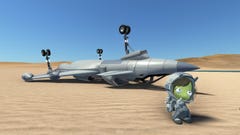Kerbal Space Program 2’s system requirements are as harsh as they look
The GTX 1070, GTX 1060 and others won’t maintain 30fps
I know we’ve been bleating on about PC system requirements lately, but the spec demands of Kerbal Space Program 2 also demand a special, visibly uncomfortable mention. This game, fresh into early access and the sequel to one that needed a mere 512GB of VRAM, lists the formidable RTX 3080 among its recommended hardware. That’s a £600-plus graphics card, and for the bare minimum of Low quality at 1080p? That’ll be either a GTX 1070 Ti or a Radeon RX 5600 XT.
Consternation at the star-high starting specs prompted Private Division community lead Michael Loreno to pen a forum post explaining the requirements, suggesting they were subject to change as further optimisations are added and that "the game is certainly playable on machines below our min spec." Sadly, I’ve been finding that several of the most-used GPUs among Steam users – including the immensely popular GTX 1060 – are likely to face serious performance woes in KSP2’s current state.
Starting with the GTX 1070, barely half a step down from the minimum spec’s Nvidia suggestion, Kerbal Space Program 2 sat at a comfortable 60fps in the rocket building workshop – albeit only at 1080p, using the lowest possible settings and forgoing anti-aliasing. This immediately plummeted to about 20fps out on the launchpad, and during my (admittedly shitty) rocket’s ascent, it dropped as low as 16fps. Breaching the clouds and looking out into deep space allowed the framerate to shoot all the back up and more, even surpassing 100fps, but then it would drop straight back down to around 20fps whenever the Earth stand-in Kerbin was onscreen.
The GTX 1060 didn’t even get the privilege of that triple-digit high. This hovered around the low fifties inside Vehicle Assembly, but launching the thing dropped KSP2 to about 15fps – with the occasional low of just 10fps. Out in space, it could reach about 45fps, though looking back at Kerbin would still tank performance.
What about much newer low-end hardware? The Radeon RX 6650 XT only launched in 2022, compared to the six-year-old GTX 1060, and yet it struggled even harder. Again it could only post a miserable 10-15fps during takeoff (remember, this is still on the lowest possible settings) and fell to 4fps upon re-entry and landing. Or crashing, in my case. Then the game crashed, apparently owing to an unresponsive graphics card.
What can this tell us, besides that you shouldn't buy an RX 6650 XT? It suggests part of the game are technically playable on PCs below the minimum spec, but to try it is to accept other parts that slow to a dejected crawl.
What’s more, all these GPU results used an Intel Core i5-11600K and 16GB of RAM as part of the test rig, and these are more in line with the recommended specs for High-quality 1440p. If you tried any of these cards with a CPU along the lines of, say, Private Division’s own minimum-level suggestions of an Intel Core i5-6400 or AMD Athlon X4 845, they’ll likely run even worse.

Loreno’s forum post claims that performance will improve over the course of early access, and that’s not at all outside the realm of possibility – even if our reviewer Steve Hogarty found plenty of other technical problems to contend with. And it’s hard to argue with this part too:
"Because no two people play the game exactly the same way (and because a physics sandbox game of this kind creates literally limitless potential for players to build anything and go anywhere), it’s very challenging to predict the experience that any particular player will have on day 1. We’ve chosen to be conservative for the time being, in order to manage player expectations."
But still, absolutely everyone will experience rocket takeoff and that initial ascent to the stars, where the biggest drops are concentrated. Is a game "certainly playable" when one of its most pivotal moments so readily falls to what, in 99% of games, would constitute unplayable performance? I’m not so sure.



















